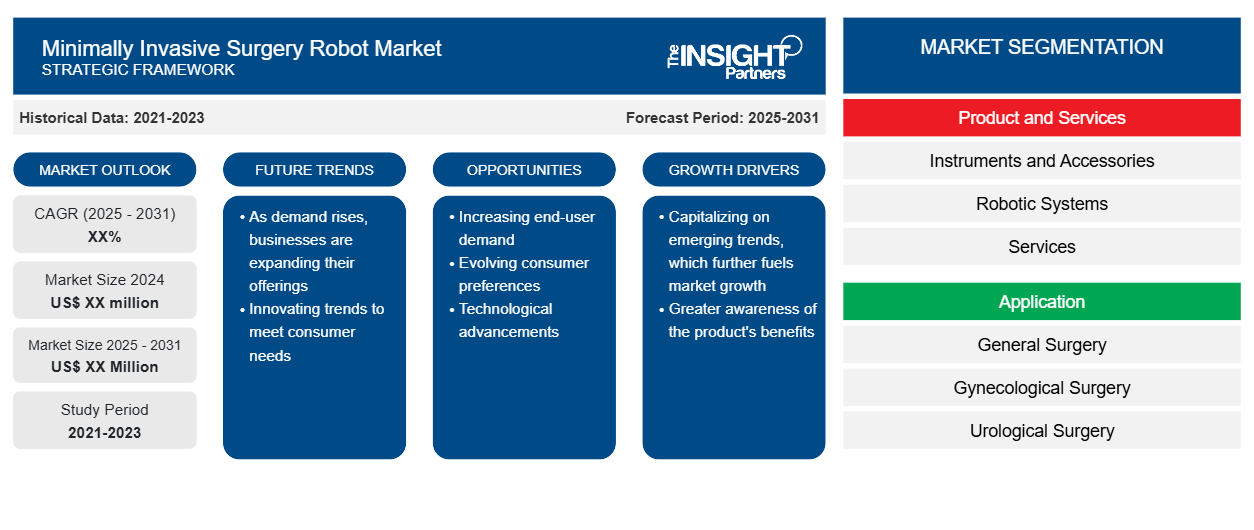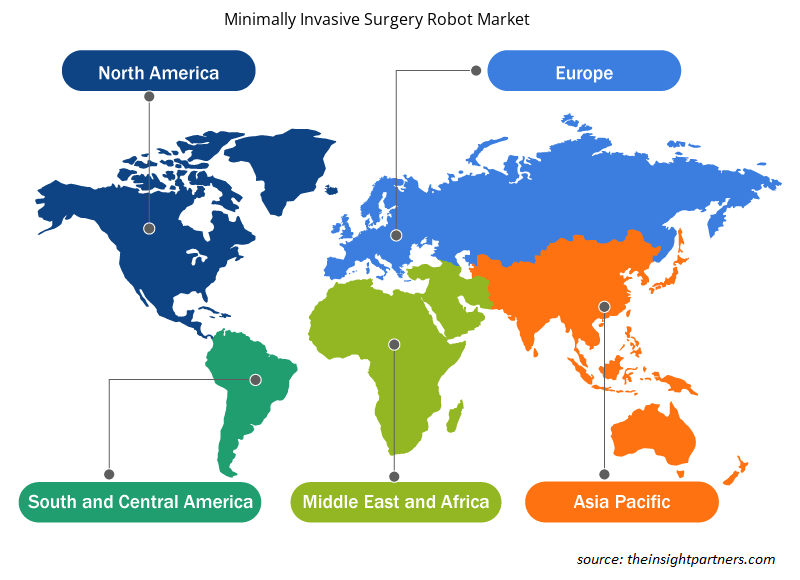低侵襲手術ロボット市場規模は、2024年の111億6,000万米ドルから2031年には291億3,000万米ドルに達すると予測されています。市場は2025年から2031年にかけて年平均成長率(CAGR)14.8%を記録すると予想されています。AIを活用した手術支援は、低侵襲手術ロボット市場における重要なトレンドとして台頭しています。
低侵襲手術ロボット市場分析
低侵襲手術ロボット市場は、高解像度3D可視化、拡張現実(AR)、リアルタイムデータ分析といった手術精度と手術結果を向上させる機能を搭載した手術ロボットの能力を大幅に向上させた技術進歩により、大幅な成長を遂げています。がん、心血管疾患、肥満といった慢性疾患の罹患率増加は、外科的介入の需要を高め、市場の成長をさらに促進しています。さらに、世界的な人口高齢化に伴い、外科手術の件数が増加しており、高度な外科技術へのニーズが高まっています。術後疼痛の軽減や回復期間の短縮といったメリットをもたらす低侵襲手術を患者が好む傾向も、市場にプラスの影響を与えています。これらの要因が相まって、低侵襲手術ロボット市場の持続的な拡大に貢献しています。
低侵襲手術ロボット市場の概要
慢性疾患の増加、ロボット工学の技術進歩、そして低侵襲手術の利点に対する消費者の意識の高まりにより、世界の低侵襲手術ロボット市場は急成長を遂げています。インテュイティブ・サージカル、メドトロニック、ストライカーといった市場の主要企業は、低侵襲手術ソリューションへの高まる需要に応えるため、継続的な革新を続けています。さらに、ロボット支援手術は、回復時間の短縮、瘢痕の最小化、手術精度の向上、そしてロボットシステムへの人工知能と機械学習の統合により、導入が進んでいます。北米は、医療費の高騰とロボットシステムの早期導入により、2024年の市場を牽引しました。アジア太平洋地域は、医療投資の増加とインフラの急速な発展に支えられ、最も急速な成長が見込まれています。
このレポートの一部、国レベルの分析、Excelデータパックなど、あらゆるレポートを無料でカスタマイズできます。また、スタートアップや大学向けのお得なオファーや割引もご利用いただけます。
低侵襲手術ロボット市場:戦略的洞察

-
このレポートの主要な市場動向を入手してください。この無料サンプルには、市場動向から見積もりや予測に至るまでのデータ分析が含まれます。
低侵襲手術ロボット市場の推進要因と機会
マイクロサージェリーの増加が市場を活性化
脳神経外科、眼科、泌尿器科、心臓血管科、再建手術など、あらゆる分野において、精密で低侵襲な手術への需要が高まっています。マイクロサージェリー(顕微手術)は、特殊な器具や顕微鏡を用いて血管、神経、小臓器などの微細構造を治療する複雑な外科手術です。これらの手術は、眼科、脳神経外科、耳鼻咽喉科、再建手術、血管外科などで広く行われています。
Global Neurosurgeryの調査によると、世界中で年間約2,260万件の脳神経外科診察が行われており、そのうち1,380万件は手術介入を必要とします。米国形成外科学会のデータによると、2023年には米国で合計157,740件の乳房再建手術が行われ、2020年の137,808件から大幅に増加しました。クリーブランド・クリニックによると、米国では血管外科医が年間10万件以上の手術・処置を行っています。最も一般的な血管手術は、末梢動脈疾患(PAD)の治療です。さらに、世界中で年間約2,000万件の白内障手術が行われており、米国では約370万件の手術が行われています。
そのため、複雑な顕微手術の増加に伴い、外科医は視覚化の向上と動作の縮小を求めており、これが先進国におけるロボットの使用を促進し、今後数年間で低侵襲手術ロボット市場の成長を促進するものと考えられます。
新興国の未開拓市場が成長機会を創出
新興経済国は、低侵襲手術(MIS)ロボットの普及にとって大きなチャンスを提供しています。これらの地域では、医療インフラの急速な進歩と、先進医療技術への政府投資の増加が見られます。
インドは、外科手術の負担が大きく、民間医療セクターが急速に拡大していることから、低侵襲手術ロボットにとって大きな成長機会を提供しています。アポロ病院、フォルティス・ヘルスケアなどは、手術の精度を高め、患者の転帰を改善するために、ダヴィンチ手術システムやVersiusなどの先進的なロボットプラットフォームの導入を加速させています。さらに、インド政府は、官民パートナーシップや医療技術パークの開発を通じて、医療技術エコシステムを積極的に支援しています。これらの取り組みは、大都市圏以外でも最先端の手術器具へのアクセスを改善し、二級都市および三級都市におけるロボット手術導入への現実的な道筋を作り出すことを目指しています。こうした低侵襲手術の需要の高まり、民間セクターへの投資の増加、そして優遇政策の増加は、新興国においてMISロボット市場にとって大きな潜在性を提供することが期待されます。
ベトナム、フィリピン、インドネシアなどの東南アジア諸国では、人口増加と慢性疾患の発症率の上昇が見られます。この地域の医療制度は質の高い外科治療の需要の高まりに直面しており、政府は医療費を増額し、医療インフラの近代化を優先しています。これにより、ロボット支援手術の導入に適した環境が整えられています。さらに、国際的な医療機器企業は、地元の病院との戦略的提携や、ロボットプラットフォームの臨床的および経済的メリットを実証するための補助金付きのパイロットプロジェクトの開始を通じて、これらの市場に参入しています。これらの取り組みは、この地域でのMIS技術の長期的な導入に対する認識の構築、トレーニング能力の拡大、および基盤の構築に役立っています。このように、新興経済国の未開拓市場は、医療需要の増加、インフラの改善、および高度な外科技術の採用意欲の高まりに牽引され、MISロボットにとって大きな成長機会を提供しており、予測期間中に市場成長の有利な機会が生まれます。
低侵襲手術ロボット市場レポート:セグメンテーション分析
低侵襲手術ロボット市場分析の基礎となる主要セグメントは、製品とサービス、アプリケーション、および最終用途です。
- 製品とサービスに基づいて、低侵襲手術ロボット市場はロボットシステム、器具と付属品、そしてサービスの3つに分類されます。2024年には、器具と付属品のセグメントが市場最大のシェアを占めました。
- 用途別に見ると、低侵襲手術ロボット市場は一般外科、婦人科外科、泌尿器科外科、脳神経外科、整形外科などに分類されます。2024年には、一般外科分野が市場の大部分を占めました。
- 最終用途別に、市場は病院、外来手術センター、その他に分類されます。2024年には、病院セグメントが低侵襲手術ロボット市場シェアの大部分を占めました。
低侵襲手術ロボット市場シェアの地域別分析
低侵襲手術ロボット市場レポートの地理的範囲は、北米、アジア太平洋、ヨーロッパ、中東およびアフリカ、南米および中米の 5 つの地域に分かれています。
2024年には北米が市場シェアを大きく伸ばしました。その主な要因は、この地域の高度な医療インフラと多額の医療費です。人工知能(AI)、機械学習、拡張現実(AR)の統合といったロボットシステムの革新は、外科用ロボットの精度と機能を向上させました。これらの進歩により、外科医は複雑な手術をより正確かつ効率的に行うことができるようになり、様々な医療分野におけるMISロボットの導入に貢献しています。北米、特に米国は医療費が高く、ロボット支援手術に対する有利な償還政策を有しています。これらの要因により、病院や外科センターは高度なロボット技術への投資を促され、MISロボットの普及が促進されています。Intuitive Surgical、Medtronic、Strykerといった大手医療用ロボット企業は、北米で強力なプレゼンスを築いています。これらの企業は、医療機関との連携に加え、継続的な研究開発活動を通じて、この地域におけるMISロボットシステムの導入と普及を加速させています。
低侵襲手術ロボット市場の地域別分析
Insight Partnersのアナリストは、予測期間を通じて低侵襲手術ロボット市場に影響を与える地域的な動向と要因を詳細に解説しています。このセクションでは、北米、ヨーロッパ、アジア太平洋、中東・アフリカ、中南米における低侵襲手術ロボット市場のセグメントと地域についても解説します。

- 低侵襲手術ロボット市場の地域別データを入手
低侵襲手術ロボット市場レポートのスコープ
| レポート属性 | 詳細 |
|---|---|
| 2024年の市場規模 | 111億6000万米ドル |
| 2031年までの市場規模 | 291億3000万米ドル |
| 世界のCAGR(2025年~2031年) | 14.8% |
| 履歴データ | 2021-2023 |
| 予測期間 | 2025~2031年 |
| 対象セグメント |
製品・サービス別
|
| 対象地域と国 |
北米
|
| 市場リーダーと主要企業の概要 |
|
低侵襲手術ロボット市場のプレーヤー密度:ビジネスダイナミクスへの影響を理解する
低侵襲手術ロボット市場は、消費者の嗜好の変化、技術の進歩、製品の利点に対する認知度の高まりといった要因によるエンドユーザーの需要増加に牽引され、急速に成長しています。需要が高まるにつれ、企業は製品ラインナップの拡充、消費者ニーズへの対応、そして新たなトレンドの活用を進めており、これが市場の成長をさらに加速させています。
市場プレーヤー密度とは、特定の市場または業界内で事業を展開する企業または会社の分布を指します。これは、特定の市場空間における競合企業(市場プレーヤー)の数が、その市場規模または市場価値全体と比較してどれだけ多いかを示します。
低侵襲手術ロボット市場で事業を展開している主要企業は次のとおりです。
- ジョンソン・エンド・ジョンソン
- ストライカー社
- メドトロニック社
- インテュイティブサージカル株式会社
- アセンサスサージカル株式会社
- スミス・アンド・ネフュー社
免責事項:上記の企業は、特定の順序でランク付けされているわけではありません。

- 低侵襲手術ロボット市場のトップキープレーヤーの概要を入手
低侵襲手術ロボット市場のニュースと最近の動向
低侵襲手術ロボット市場は、主要な企業出版物、協会データ、データベースを含む一次調査および二次調査に基づく定性・定量データの収集によって評価されています。市場における主要な動向は以下の通りです。
- ジョンソン・エンド・ジョンソン メドテックは、MONARCHナビゲーション技術の最新鋭機であるMONARCH QUESTが米国510(k)規制当局の承認を取得したことを発表しました。本製品はAI搭載アルゴリズムと、GEヘルスケアOEC 3DモバイルCBCTイメージングシステムとの検証済みOEC Openインターフェースを備えています。ロボット支援気管支鏡検査は、米国における肺生検において、規模は小さいものの急速に成長している分野です。市場初のロボット支援気管支鏡検査システムであるMONARCHプラットフォームは、気道への低侵襲アクセスと可視化を提供し、医師による疑わしい肺結節の生検を支援します。(出典:ジョンソン・エンド・ジョンソン サービス社、プレスリリース、2025年3月)
- ストライカーは、ラスベガスで開催されたAAOS 2023年次総会において、Mako SmartRoboticsの次なる章となるMako Total Knee 2.0を発表しました。50万件を超えるMako Total Knee手術の実績に基づき開発されたMako Total Knee 2.0は、外科医がMakoに期待する信頼性の高い成果を、新たな、より高度なユーザーエクスペリエンスによって実現するように設計されています。(出典:ストライカー、プレスリリース、2023年3月)
低侵襲手術ロボット市場レポートの対象範囲と成果物
「低侵襲手術ロボット市場規模と予測(2021〜2031年)」レポートでは、以下の分野を網羅した市場の詳細な分析を提供しています。
- スコープに含まれるすべての主要市場セグメントについて、世界、地域、国レベルでの低侵襲手術ロボット市場規模と予測
- 低侵襲手術ロボット市場の動向と市場動向(推進要因、制約、主要な機会など)
- 詳細なPEST分析とSWOT分析
- 主要市場動向、世界および地域の枠組み、主要プレーヤー、規制、最近の市場動向を網羅した低侵襲手術ロボット市場分析
- 市場集中、ヒートマップ分析、主要プレーヤー、低侵襲手術ロボット市場の最近の動向を網羅した業界の展望と競争分析
- 詳細な企業プロフィール
- 過去2年間の分析、基準年、CAGRによる予測(7年間)
- PEST分析とSWOT分析
- 市場規模価値/数量 - 世界、地域、国
- 業界と競争環境
- Excel データセット
最新レポート
お客様の声
購入理由
- 情報に基づいた意思決定
- 市場動向の理解
- 競合分析
- 顧客インサイト
- 市場予測
- リスク軽減
- 戦略計画
- 投資の正当性
- 新興市場の特定
- マーケティング戦略の強化
- 業務効率の向上
- 規制動向への対応






















 無料サンプルを入手 - 低侵襲手術ロボット市場
無料サンプルを入手 - 低侵襲手術ロボット市場